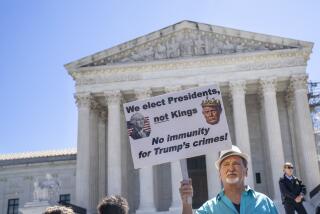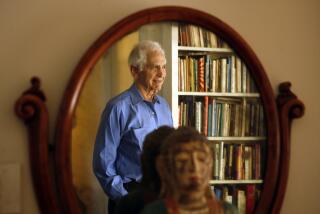Books Depict Bush as Instinct-Driven Leader
- Share via
WASHINGTON — President Bush styles himself as the first CEO president, applying the rigor and authority of his MBA education to the job of chief executive of the nation.
But that’s not the picture that emerges from three recent insider accounts of the workings of the Bush administration, experts in decision-making and presidential management say. On the contrary, they say, the president appears to have a highly personal working style, with little emphasis on systematic analysis of major decisions.
“There seems to be almost an absence of any analytical or deliberative process for mapping the problem or exploring alternatives or estimating consequences,” said Graham Allison, a professor of government at the Kennedy School of Government at Harvard University.
And Bush appears to give greater weight to his own instincts than to experts or other sources of advice and information. The president has a “bias for action,” said Roderick M. Kramer, a professor of organizational behavior at Stanford’s Graduate School of Business. “I’ve been struck by [how] Bush’s sense of personal identity as a leader shapes his decisions,” he said.
For the last three years, experts on the presidency have largely withheld judgment about how the Bush White House -- considered the most secretive since Richard Nixon’s -- makes major decisions. The experts thought they had inadequate information to reach general conclusions.
That has changed. Scholars of management and government have begun to pore through this spring’s crop of insider books and draw preliminary assessments of how Bush operates as president. And their main conclusion is that he makes decisions primarily on instinct, not analysis.
Kramer, for example, said: “I would contrast his style to someone like [Nixon’s former Secretary of State] Henry Kissinger, who looked at decisions more in terms of a balance of power and what is realistic to achieve, thinking about how the rest of the world will respond.”
For Bush, by contrast, “emotion and vision and instinct are his view of the world.” That can be a good thing, Kramer added. “He bases his decisions on a few principles, but if those principles are good principles, that can lead to good decisions.”
The three insider books are as different as the insiders who wrote them. The first, “The Price of Loyalty,” reflects the experience of former Treasury Secretary Paul H. O’Neill, the former Alcoa chief executive who was forced out for dissenting over economic policy.
The second, “Against All Enemies,” was written by career bureaucrat and former counterterrorism chief Richard A. Clarke, who thought the administration was inattentive to the dangers of terrorism. And the third, “Plan of Attack” by Bob Woodward, is a journalist’s account of the war on Iraq based on interviews with the president and his advisors.
In addition, two books by Bush loyalists -- advisor Karen Hughes’ “Ten Minutes from Normal” and former speechwriter David Frum’s “The Right Man” -- are also insider accounts, though they shed less light on the White House decision-making process. Frum left the White House early in the administration, and Hughes, a longtime supporter, offers only a few, unfailingly flattering glimpses of her boss in action.
The O’Neill, Clarke and Woodward accounts have strengths and weaknesses, reflecting the experience, access or bias of the authors, scholars say. But by looking at all the books, they say they can begin to overcome the inadequacies of any single account.
“Triangulate is an excellent image,” said Fred I. Greenstein, a presidential historian at Princeton University. “These books certainly tell you things.”
Greenstein said that one striking thing about all three books was what they don’t show. There are few examples, for instance, of Bush presiding over meetings in which subordinates presented problems, weighed evidence and aired differing views.
“I think a lot of policy is made on the fly,” he said. “It isn’t a process in which people assemble and go back and forth in a rigorous way.”
Another thing largely missing from the books was any indication that documents or memos weighing policy alternatives are circulated and discussed. Harvard’s Allison said one of the few documents the administration did prepare in advance of the Iraq war -- the 2002 National Intelligence Estimate that concluded that Iraq probably had weapons of mass destruction -- was quickly compiled and not very well done.
“The more it’s examined, it seems quite sloppy,” he said. “At this point, if there had been some good analysis of the issues on paper, we would have seen some evidence of it.
“The contrast with the textbook conception of informed decision making is distressing,” he said.
Without a framework for analysis, many important policy discussions appeared to have been disorganized at best, the management specialists say.
O’Neill, himself a legendary chief executive, was scathing in his depiction of a meeting Bush held to decide whether to push for a second round of tax cuts, describing the discussion as haphazard as “June bugs hopping around on a lake.”
“Without the hard, factual analysis that allows you to make informed judgments about the worth of various proposals, [that’s] about what you can expect,” he said.
Sometimes, policy discussions seem not to have taken place at all.
In the Woodward book, Secretary of State Colin L. Powell is depicted as attending an National Security Council war planning meeting on Aug. 5, 2002, and realizing that the president and his top advisors were discussing details such as troop deployments and targets in Iraq without ever having held an NSC meeting on the question of whether to go to war in the first place.
“I really need to have some private time with [the president] to go over some issues that I don’t think he’s gone over with anyone yet,” the book quotes Powell as telling national security advisor Condoleezza Rice.
According to the book, Powell never took part in a debate over whether to go to war, only talks on how to attack.
Stanford’s Kramer said though Bush showed little interest in the kind of number-crunching analysis taught in business school, his style of management does conform to the popular image of chief executives as forceful and “decisive.” “There seems to be a lot of value attached to showing resolve and demonstrating resolve,” he said.
But Jay Lorsch, a professor at Harvard Business School and author of “Decision Making at the Top,” said the decision-making techniques taught at that school -- from which Bush received an MBA -- focus on understanding the nature of decisions, not simplifying them.
“What we teach around here is that you’ve got to understand the complexity of the territory you’re trying to affect,” he said. “You don’t make a decision until you’ve surveyed all the possible ramifications. The binary idea that you’re either right or wrong is just foolishness.”
Another critical part of MBA-style analysis is understanding and compensating for your own assumptions, Lorsch said.
Decision makers who are inadequately aware of their assumptions leave themselves vulnerable to two errors: First, subordinates learn to tell them what they want to hear. Second, they are less rigorous in processing data and gauging its validity.
“Whether it’s O’Neill or Clarke or Woodward, the theme that runs through all of them is that there was an obsession with Iraq,” Lorsch said. “They were probably interpreting the data in a way consistent with their beliefs.”
Martha Joynt Kumar of the University of Maryland said the books also depicted Bush as being largely unconcerned with the quality of information he received.
“He doesn’t like long meetings. He likes truncated meetings. That means you’re not going to have the kinds of sessions ... that are going to bring in lots of different kinds of information,” Kumar said.
Greenstein said that when weighing an important decision such as whether to go to war, specialists in the presidency generally think it is better for presidents to hold meetings in which dissenting views are heard and weighed. That way, the president is seen as considering all the angles.
“It is generally seen as less desirable to see your advisors individually” as Bush appears to have done before deciding to wage war on Saddam Hussein, Greenstein said. “That will raise the question of, does the person who talks to the president last have undue influence? And it also gives influence to those who are better at bureaucratic turf battles.”
Of course, every president operates differently, and each administration reflects the personality of the chief executive. President Eisenhower was formal and bureaucratic, scholars say, reflecting his military background. President Kennedy was more informal or even haphazard, but he cast a wide net for information before settling on an answer, as did President Clinton.
In practice, Bush appears closest to the style of Reagan, said Bert A. Rockman, director of the School of Public Policy and Management at Ohio State University.
“The decisiveness part is certainly there,” he said. “The imperviousness to facts and analysis is also there. So what we have is someone who is going on raw instinct.”
A corollary, Rockman said, is that though Bush likes making decisions, his organizational style is not very good at implementation or follow-up.
Richard K. Betts, director of the Institute of War and Peace Studies at Columbia University, said that though Bush’s style was similar to Reagan’s, he seemed to rely on a narrower circle of advisors.
“Bush appears to rest his confidence in a few people whose judgment corresponds to his gut instincts” he said. “He seems to be obsessive about being decisive, but willing to make hard and fast decisions on the basis of ideology more than evidence.”
Kramer of Stanford’s Graduate School of Business said he suspects that the current president may be consciously or unconsciously reacting to his father’s reputation for prudence -- a trait some in the current administration have criticized because it led George H.W. Bush to end the Gulf War without removing Saddam Hussein.
“Decision makers are influenced by historical comparisons, and he may be overcorrecting, trying not to be like his father,” Kramer said.
So far at least, scholars say, it appears that Bush’s personality -- not his staff, and not his organizational structure -- is the key to understanding his presidency. Kumar of the University of Maryland said that was similar to her analysis of previous presidents.
“We often think that a White House staff is going to fill in, to compensate for a president’s weaknesses. But it doesn’t really work that way,” she said. “White Houses reflect their president’s strengths and also reflect his weaknesses.”
More to Read
Sign up for Essential California
The most important California stories and recommendations in your inbox every morning.
You may occasionally receive promotional content from the Los Angeles Times.










